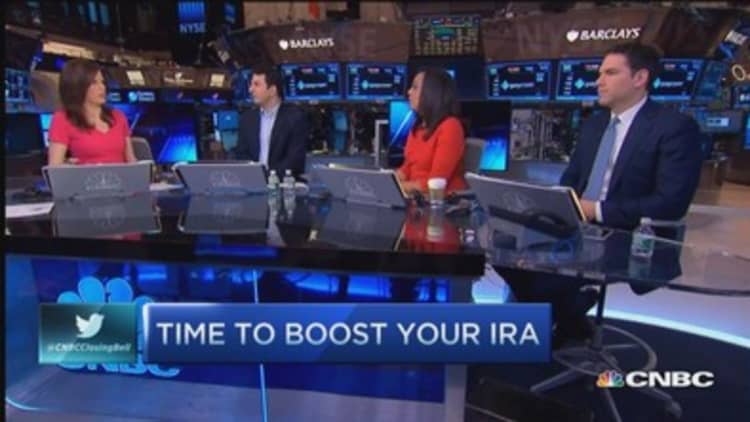
Most Americans know they should be saving more, but few of them are actually making plans to do it.
Twenty-eight percent of workers have less than $1,000 in savings that could be applied toward their retirement, according to a new Employee Benefit Research Institute (EBRI) and Greenwald and Associates survey. And of the pool of respondents—1,003 workers and 1,001 retirees interviewed by phone—57 percent say they have less than $25,000 in retirement savings. (Tweet This)
That may help explain why nearly six in 10 Americans (58 percent) believe their financial planning needs improvements and 21 percent are "not at all confident" they'll be able to reach their financial goals, according to separate data released this week from Northwestern Mutual's 2015 Planning & Progress Study.
While a majority have taken steps to address that, 34 percent said they have taken no action at all.
"Intending one thing and doing another is human, but it's an impulse we should all fight hard to resist," said Rebekah Barsch, vice president of planning and sales at Northwestern Mutual, in a statement. "Intentions only get us so far. And when the stakes are high, it's taking action that's critical."
There's no question the stakes are high.
With health-care costs rising and lifespans increasing, retirement has become an increasingly expensive proposition.
According to the latest report by HealthView Services, which helps financial advisors forecast health-care costs for their clients, the average lifetime retirement health-care premium costs for afit, hypothetical 65-year-old couple retiring this year is now $266,589, including Medicare parts B and D coverage as well as supplemental insurance. (The estimate assumes a life expectancy of 87 years for men, and 89 for women.)
Read MoreRetiree health-care costs may be higher than you think
Americans are also living longer after they stop working, which means their savings have to last longer. A man reaching age 65 in 1970 could expect to live 13 more years, but by 2011 that figure was 18 years. A woman's life expectancy at age 65 rose from 17 years in 1970 to 20 years in 2011 (the most recent year for which such data is available from the Centers for Disease Control).
Not surprisingly, a growing number of Americans are worried about running out of savings in retirement. Almost two-thirds of workers (64 percent) say they feel they are behind schedule when it comes to planning and saving for retirement, according to the EBRI Retirement Confidence Survey report.
"People don't prioritize retirement savings enough. A lot of people are hemmed in by high expenses, stagnant incomes and find it difficult to save in a meaningful way for retirement or anything else," said Greg McBride, chief financial analyst for Bankrate.com.
Craig Copeland, senior research associate at EBRI, said having an employer-sponsored plan can help. The survey found savings and investment rates were higher among workers with a retirement plan like an IRA, a defined contribution plan like a 401(k) or defined benefit plan like a pension. Among those without a plan, the percentage of workers who saved less than $1,000 was seven times more than those with a plan.
"Those without a retirement plan seem to understand they are likely to have difficulties accumulating adequate financial resources for retirement," said Jack VanDerhei, EBRI research director and co-author of the report, in a statement.
Read More How to get lucky with your savings
As a result, some said they planned to postpone retirement for years, even indefinitely. About 36 percent of workers surveyed by the EBRI said they expected to retire after age 65. And 10 percent said they didn't plan to retire at all.
That has many financial advisors concerned. "The notion that you are going to work forever is not a sound retirement plan," said McBride. "That's not entirely under your control."
In fact, Copeland pointed out that in the EBRI survey "many retirees continue to report that they retired before they expected to due to an illness or disability, needing to care for others, or because of a change at their job."
Marty Durbin, a personal financial specialist at Aperture Retirement Designs in Arlington, Texas, suggests that instead more efforts should be made to boost participation in retirement plans.
Read MoreA simple savings tactic that can boost your nest egg
Many employers have tried to increase employee participation by automatically enrolling them in retirement plans with an opt-out option. There have also been efforts to provide more ways to save for those without access to employer-sponsored plans.
Two Democratic lawmakers proposed legislation in January that would allow workers to automatically deposit payroll contributions into IRAs if they didn't have access to other retirement plans. The Automatic IRA Act would also mandate employers with 10 or more workers to participate, unless enough employees opted out. (It's worth noting, though, that similar legislation has been proposed for the last five years without adoption.)
In the meantime, the Treasury has also begun rolling out the myRA—short for "my Retirement Account"—that was introduced by President Barack Obama in his State of the Union address last year, another effort to get the approximately 50 million Americans who don't have access to a 401(k) retirement plan through their employers a vehicle for saving for retirement.
A shift in mindset among workers themselves could help, too, said Durbin. "We have a consuming society and not much of saving society," he said. "We need to help get people more involved in thinking about their futures."

